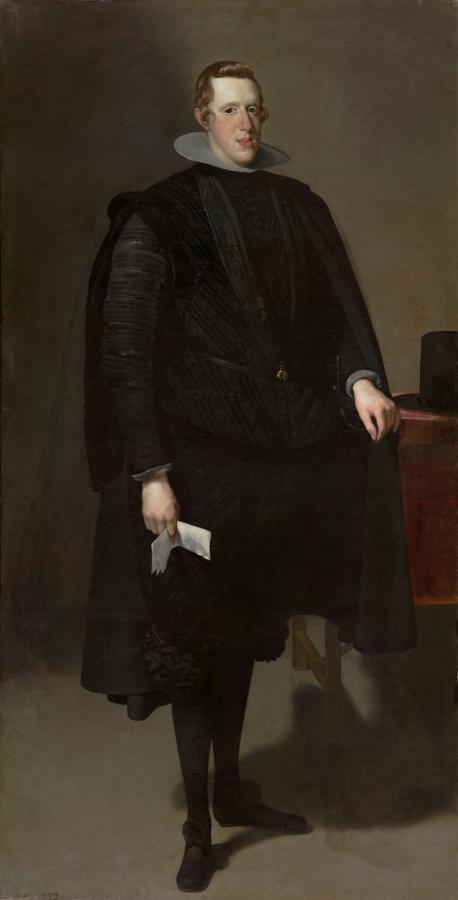Velázquez, Diego (1599-1660)
Felipe IV (Philip IV)
1623
Oil on canvas, 198 x 101.5 cm
Museo del Prado, Madrid
We see King Philip IV of Spain (r. 1621-1665) when he was around twenty years old in an austere image filled with references to his status and responsibilities and to the reformist intentions with which he began his reign. The sword on whose hilt his left hand rests and the desk bearing a top allude to the administration of justice and the defense of his kingdoms. The Golden Fleece hanging at his waist symbolizes his lineage, while the paper in his right hand refers to his administrative duties. Even his suit is charged with meaning. It is much more sober than was customary in earlier royal portraits, lacking jewels and other adornments, and it is topped by a valona, a Walloon collar of the sort that replaced the more decorative and costly lechuguilla (ruff) in 1623. When this portrait was made, that plainer collar constituted the most important symbol of the desire for austerity, reform, work, and attention to public welfare that characterized the early reign of Philip IV, who sought to distance himself from the image of favoritism, caprice, and squandering associated with his predecessor, his father, King Philip III (r. 1598-1621). During those early years of his reign, Philip IV frequently appeared in public with more costly and adorned clothing, but the official image created by Velázquez avoids these adornments and emphasizes one of the king’s most important activities as a ruler: his audiences. According to contemporary observers, he received his visitors on such occasions much as he is shown here: standing, leaning on a desk, and wearing the Golden Fleece. This play of references replete with political intent is brought out by the composition and the manner of painting. Velázquez places the king in a very stark space shaped with extremely subtle gradations of light and color and devoid of customary accessories such as curtains. Within this space, he locates the King very close to the viewer, wearing a suit painted with a prodigious variety of dark shades of color. The monarch’s posture is firm but relaxed, and the rendering of his face culminates a process of simplification that began with the portrait at the Meadows Museum; the result is an impassive expression directly related to the idea of royal majesty. With all those elements, Velázquez fashions an image of the king that differs considerably from any earlier one. The exceptional coherence between pictorial construction and narrative or symbolic elements places this among the summits of Spanish court portraiture, especially for its capacity to convey political ideals. In its current state, the portrait reflects the manipulation of an earlier work, also by Velázquez. We know this through an X-radiography, as well as from versions and copies of the first image, including the version at the Metropolitan Museum of Art in New York and the copy at the Museum of Fine Arts, Boston. That first work dates from the months following August 30, 1623, when Velázquez made his first portrait of the king, which must have been a bust and may well be the work at the Meadows. With that as his model, he made a full-length portrait, which he significantly modified three or four years later, changing both its composition and its content. He made the figure more slender, reduced the cape’s fullness, and brought the king’s two feet much closer together. He raised the desk (which was abnormally low in the first version) to the height of the king’s hand, increased the visible surface of the paper in the right hand, and modified the face considerably. These changes served two purposes. First, they adjusted the monarch’s age to indicate his twenty-two or twenty-three years when the painting was redone. Second, by lengthening the king’s features and presenting them in a more summary fashion, they increased the sense of distance and majesty. Nowadays, works of art from the past are so highly respected that this type of operation may strike us as strange, but such alterations were actually quite common in court portraits, and not at all rare in Velázquez‘s circles. When he copied Peter Paul Rubens‘s (1577-1640) equestrian portrait of Philip IV in the late 1640s, for example, he transformed the king’s face to convey his age at the time. Likewise, Philip IV in Armour, with a Lion at His Feet (P01219), a canvas associated with Velázquez‘s workshop, was originally painted in the late 1630s, then updated at the beginning of the 1650s. (Portús Pérez, Javier, Philip IV, c. 1623-1628. En: Diego Velázquez. The Early Court Portraits, Dallas, Meadows Museum–SMU–MNP, 2012, p.86-87, n. 1 [185-186])
See also:
• Felipe IV, King of Spain (1605-1665)
